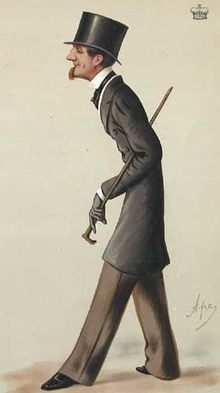John Thynne, 4th Marquess of Bath

John Alexander Thynne, 4th Marquess of Bath (1 March 1831 – 20 April 1896), styled Viscount Weymouth between March and June 1837, was a British peer and a diplomat for almost sixty years.
Background and education
Born in St James's, he was the son of Henry Thynne, 3rd Marquess of Bath and his wife Harriet, second daughter of Alexander Baring, 1st Baron Ashburton.[1] He succeeded his father as Marquess in June 1837, aged only six.[1] Lord Bath was educated at Eton College and Christ Church, Oxford. He was a devout Anglo-Catholic and a determined opponent of the Public Worship Regulation Act 1874 which sought to suppress Ritualism in the Church of England.
Career
He held the office of Envoy Extraordinary for the coronation of King Pedro V of Portugal on 27 May 1858, and Envoy Extraordinary for the coronation of the Emperor Franz Joseph I as King of Hungary on 25 July 1867.
From 1874 to 1893, he was a trustee of the National Portrait Gallery, as well as a trustee of the British Museum in 1883. He was Chairman of Wiltshire County Council and, having been a Deputy Lieutenant of Somerset from 1853, was appointed Lord Lieutenant of Wiltshire in 1889, a post he held until his death in 1896.
Family and death
He married Frances Isabella Catherine Vesey, daughter of Thomas Vesey, 3rd Viscount de Vesci, on 20 August 1861. They had six children:
- Sir Thomas Henry Thynne, 5th Marquess of Bath (1862–1946)
- Lady Alice Emma Thynne (c. 1863–1942), married Sir Michael Shaw-Stewart, 8th Baronet.
- Lady Katherine Georgina Louisa Thynne (c. 1865–1933), married Evelyn Baring, 1st Earl of Cromer and had issue.
- Lord John Boteville Thynne (1867–1887), died young and unmarried.
- Lady Beatrice Thynne (1867–1941), died unmarried.
- Lieut.-Col. Lord Alexander George Boteville Thynne (1873–14 September 1918),[2] who was a member of parliament for Bath,[2] commanded the 6th Bn. of the Wiltshire Regiment,[2] was awarded the Croix de Guerre (France),[2] was killed in action,[2] and died unmarried.[2]
Lord Bath died in 1896, aged 65, in Italy and was buried at Longbridge Deverill, Wiltshire.
| Family tree summary for the Thynnes of Longleat from about 1500[3] | |||||||||||||||||||||||||||||||||||||||||||||||||||||||||||||||||||||||||||||||||||||||||||||||||||||||||||||||||||||||||||||||||||||||||||||||||||||||||||||||||||||||||||||||||||||||||||||||||||||||||||||||||||||||||||||||||||||||||||||||||||||||||||||||||||||||||||||||||||||||||||||||||||||||||||||||||||||||||||||||||||||||||||||||||||||||||||||||||||||||||||||||||||||||||||||||||||||||||||||||||||||||||||||||||||||||||||||||||||||||||||||||||||||||||||||||||||||||||||||||||||||||||||||||||||||||||||||||||||||||||||||||||||||||||||||||||||||||||||||||||||||||||||||||||||||||||||||||||||||||||||||||||||||||||||||||||||||||||||||||||||||||||||||||||||||||||||||||||||||||||||||||||||||||||||||||||||||||||||||||||||||||||||||||||||||||||||||||||||||||||||||||||||||||||||||||||||||||||||||||||||||||||||||||||||||||||||||||||||||||||||||||||||||||||||||||||||||||||||||||||||||||||||||||||||||||||||||||||||||||||||||||||||||||||||||||||||||||||||||||||||||||||||||||||||||||||||||||||||||||
|---|---|---|---|---|---|---|---|---|---|---|---|---|---|---|---|---|---|---|---|---|---|---|---|---|---|---|---|---|---|---|---|---|---|---|---|---|---|---|---|---|---|---|---|---|---|---|---|---|---|---|---|---|---|---|---|---|---|---|---|---|---|---|---|---|---|---|---|---|---|---|---|---|---|---|---|---|---|---|---|---|---|---|---|---|---|---|---|---|---|---|---|---|---|---|---|---|---|---|---|---|---|---|---|---|---|---|---|---|---|---|---|---|---|---|---|---|---|---|---|---|---|---|---|---|---|---|---|---|---|---|---|---|---|---|---|---|---|---|---|---|---|---|---|---|---|---|---|---|---|---|---|---|---|---|---|---|---|---|---|---|---|---|---|---|---|---|---|---|---|---|---|---|---|---|---|---|---|---|---|---|---|---|---|---|---|---|---|---|---|---|---|---|---|---|---|---|---|---|---|---|---|---|---|---|---|---|---|---|---|---|---|---|---|---|---|---|---|---|---|---|---|---|---|---|---|---|---|---|---|---|---|---|---|---|---|---|---|---|---|---|---|---|---|---|---|---|---|---|---|---|---|---|---|---|---|---|---|---|---|---|---|---|---|---|---|---|---|---|---|---|---|---|---|---|---|---|---|---|---|---|---|---|---|---|---|---|---|---|---|---|---|---|---|---|---|---|---|---|---|---|---|---|---|---|---|---|---|---|---|---|---|---|---|---|---|---|---|---|---|---|---|---|---|---|---|---|---|---|---|---|---|---|---|---|---|---|---|---|---|---|---|---|---|---|---|---|---|---|---|---|---|---|---|---|---|---|---|---|---|---|---|---|---|---|---|---|---|---|---|---|---|---|---|---|---|---|---|---|---|---|---|---|---|---|---|---|---|---|---|---|---|---|---|---|---|---|---|---|---|---|---|---|---|---|---|---|---|---|---|---|---|---|---|---|---|---|---|---|---|---|---|---|---|---|---|---|---|---|---|---|---|---|---|---|---|---|---|---|---|---|---|---|---|---|---|---|---|---|---|---|---|---|---|---|---|---|---|---|---|---|---|---|---|---|---|---|---|---|---|---|---|---|---|---|---|---|---|---|---|---|---|---|---|---|---|---|---|---|---|---|---|---|---|---|---|---|---|---|---|---|---|---|---|---|---|---|---|---|---|---|---|---|---|---|---|---|---|---|---|---|---|---|---|---|---|---|---|---|---|---|---|---|---|---|---|---|---|---|---|---|---|---|---|---|---|---|---|---|---|---|---|---|---|---|---|---|---|---|---|---|---|---|---|---|---|---|---|---|---|---|---|---|---|---|---|---|---|---|---|---|---|---|---|---|---|---|---|---|---|---|---|---|---|---|---|---|---|---|---|---|---|---|---|---|---|---|---|---|---|---|---|---|---|---|---|---|---|---|---|---|---|---|---|---|---|---|---|---|---|---|---|---|---|---|---|---|---|---|---|---|---|---|---|---|---|---|---|---|---|---|---|---|---|---|---|---|---|---|---|---|---|---|---|---|---|---|---|---|---|---|---|---|---|---|---|---|---|---|---|---|---|---|---|---|---|---|---|---|---|---|---|---|---|---|---|---|---|---|---|---|---|---|---|---|---|---|---|---|---|---|---|---|---|---|---|---|---|---|---|---|---|---|---|---|---|---|---|---|---|---|---|---|---|---|---|---|---|---|---|---|---|---|---|---|---|---|---|---|---|---|---|---|---|---|---|---|---|---|---|---|---|---|---|---|---|---|---|---|---|---|---|---|---|---|---|---|---|---|---|---|---|---|---|---|---|---|---|---|---|---|---|---|---|---|---|---|---|---|---|---|---|---|---|---|---|---|---|---|---|---|---|---|---|---|---|---|---|---|---|---|---|---|---|---|---|---|---|---|---|---|---|---|---|---|---|---|---|---|---|---|---|---|---|---|---|---|---|---|---|---|---|---|---|---|---|---|---|---|---|---|---|---|---|---|---|---|---|---|---|---|---|---|---|---|---|---|---|---|---|---|---|---|---|---|---|---|---|---|---|---|---|---|---|---|---|---|---|---|---|---|---|---|---|---|---|---|---|---|---|---|---|---|---|---|---|---|---|---|---|---|---|---|---|---|---|---|---|---|---|---|---|---|---|---|---|---|---|---|---|---|---|---|---|---|---|---|---|---|---|---|---|---|---|---|---|---|---|---|---|---|---|---|---|---|---|---|---|---|---|---|---|---|---|---|---|---|---|---|---|---|---|---|---|---|---|---|---|---|---|---|---|---|---|---|---|---|---|---|---|
| |||||||||||||||||||||||||||||||||||||||||||||||||||||||||||||||||||||||||||||||||||||||||||||||||||||||||||||||||||||||||||||||||||||||||||||||||||||||||||||||||||||||||||||||||||||||||||||||||||||||||||||||||||||||||||||||||||||||||||||||||||||||||||||||||||||||||||||||||||||||||||||||||||||||||||||||||||||||||||||||||||||||||||||||||||||||||||||||||||||||||||||||||||||||||||||||||||||||||||||||||||||||||||||||||||||||||||||||||||||||||||||||||||||||||||||||||||||||||||||||||||||||||||||||||||||||||||||||||||||||||||||||||||||||||||||||||||||||||||||||||||||||||||||||||||||||||||||||||||||||||||||||||||||||||||||||||||||||||||||||||||||||||||||||||||||||||||||||||||||||||||||||||||||||||||||||||||||||||||||||||||||||||||||||||||||||||||||||||||||||||||||||||||||||||||||||||||||||||||||||||||||||||||||||||||||||||||||||||||||||||||||||||||||||||||||||||||||||||||||||||||||||||||||||||||||||||||||||||||||||||||||||||||||||||||||||||||||||||||||||||||||||||||||||||||||||||||||||||||||||
Titles
- John Alexander Thynne, Lord Thynne 1831–1837
- John Alexander Thynne, Viscount Weymouth 1837
- John Alexander Thynne, Marquess of Bath 1837–1896
References
- ^ a b Dod, Robert P. (1860). The Peerage, Baronetage and Knightage of Great Britain and Ireland. London: Whitaker and Co. p. 107.
- ^ a b c d e f Record at Commonwealth War Graves Commission website
- ^ Burke, Sir Bernard, (1938 ed) Burke's Peerage, Baronetage and Knightage. Shaw, London. p. 243
- ^ a b c Woodfall, H. (1768). The Peerage of England; Containing a Genealogical and Historical Account of All the Peers of that Kingdom Etc. Fourth Edition, Carefully Corrected, and Continued to the Present Time, Volume 6. p. 258.
- ^ a b Lee, Sidney; Edwards, A. S. G. (revised) (2004). "Thynne, William (d. 1546)". Oxford Dictionary of National Biography (online ed.). Oxford University Press. doi:10.1093/ref:odnb/27426. (Subscription or UK public library membership required.)
- ^ Girouard, Mark, Thynne, Sir John (1515–1580), estate manager and builder of Longleat in Oxford Dictionary of Biography (Oxford University Press, 2004)
- ^ Booth, Muriel. "Thynne, John (?1550–1604), of Longleat, Wilt". History of Parliament. The History of Parliament Trust. Retrieved 2 January 2016.
- ^ Lancaster, Henry; Thrush, Andrew. "Thynne, Charles (c.1568–1652), of Cheddar, So". History of Parliament. The History of Parliament Trust. Retrieved 2 January 2016.
- ^ Pugh, R. B.; Crittall, Elizabeth, eds. (1957). "Parliamentary history: 1529–1629". A History of the County of Wiltshire. Vol. 5. London: Victoria County History – via British History Online.
- ^ Ferris, John P. "Thynne, Sir James (c.1605-70), of Longbridge Deverill, Wilt". History of Parliament. The History of Parliament Trust. Retrieved 2 January 2016.
- ^ Helms, M. W.; Ferris, John P. "Thynne, Sir Thomas (c.1610–c.69), of Richmond, Sur". History of Parliament. The History of Parliament Trust. Retrieved 2 January 2016.
- ^ Marshall, Alan (2008) [2004]. "Thynne, Thomas [nicknamed Tom of Ten Thousand] (1647/8–1682)". Oxford Dictionary of National Biography (online ed.). Oxford University Press. doi:10.1093/ref:odnb/27423. (Subscription or UK public library membership required.)
- ^ Heath-Caldwell, J. J. "Thomas Thynne, 1st Marquess of Bath, 3rd Viscount Weymouth". JJ Heath-Caldwell. Retrieved 2 January 2016.
- ^ Hayton, D. W. "Thynne, Hon. Henry (1675-1708)". The History of Parliament. The History of Parliament Trust. Retrieved 2 January 2016.
- ^ Dunaway, Stewart (2013). Lord John Carteret, Earl Granville: His Life History and the Granville Grants. Lulu. p. 33. ISBN 9781300878070.
- ^ "Bath, Thomas Thynne". Encyclopedia Britannica 1911. Retrieved 2 January 2016.
- ^ Thorne, Roland. "Carteret [formerly Thynne], Henry Frederick". Oxford Dictionary of National Biography. Retrieved 2 January 2016.
- ^ "Thomas Thynne, 2nd Marquess of Bath (1765–1837)". National Portrait Gallery. Retrieved 2 January 2016.
- ^ Escott, Margaret. "Thynne, Lord Henry Frederick (1797-1837), of 6 Grovesnor Square, Md". History of Parliament. The History of Parliament Trust. Retrieved 2 January 2016.
- ^ "John Thynne, 4th Marquess of Bath (1831-1896), Diplomat and landowner". National Portrait Gallery. Retrieved 2 January 2016.
External links
- Hansard 1803–2005: contributions in Parliament by John Thynne, 4th Marquess of Bath
- Bath, John Alexander Thynne, 4th Marquess of (1880). Observations on Bulgarian Affairs. London: Macmillan. Retrieved 15 October 2013.
{{cite book}}: CS1 maint: multiple names: authors list (link) CS1 maint: numeric names: authors list (link)
